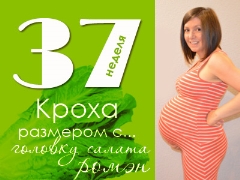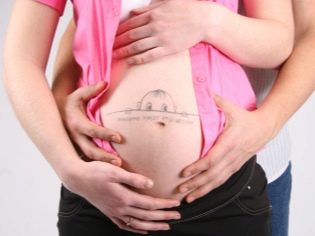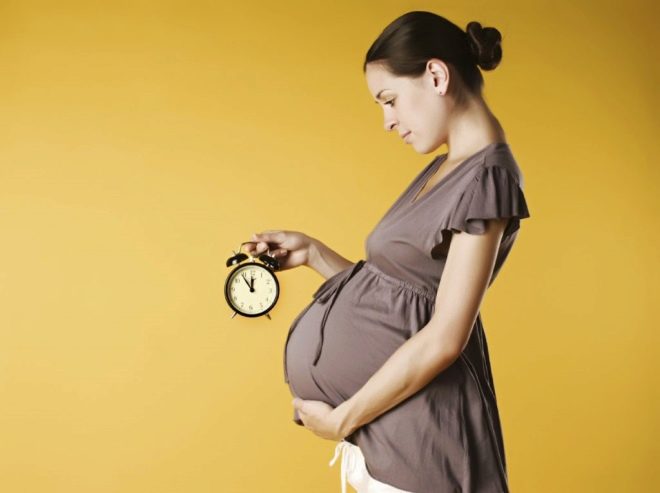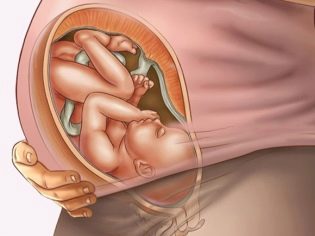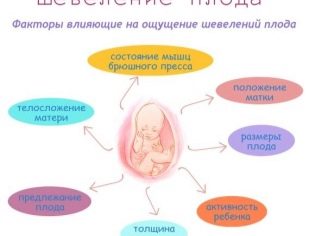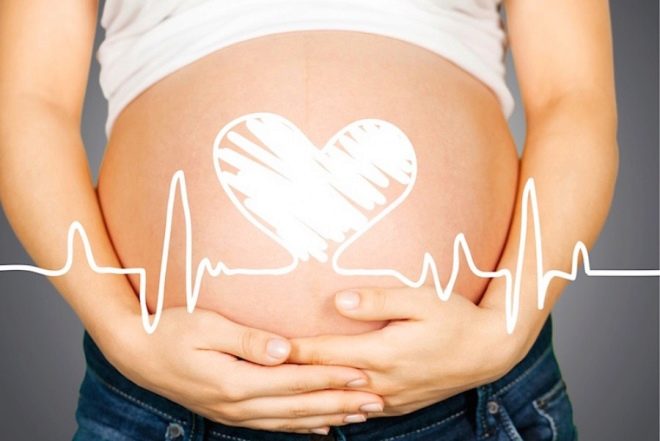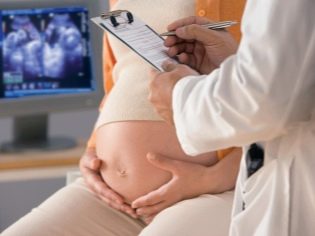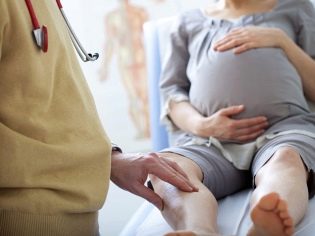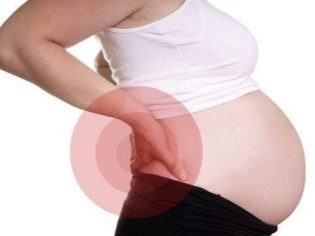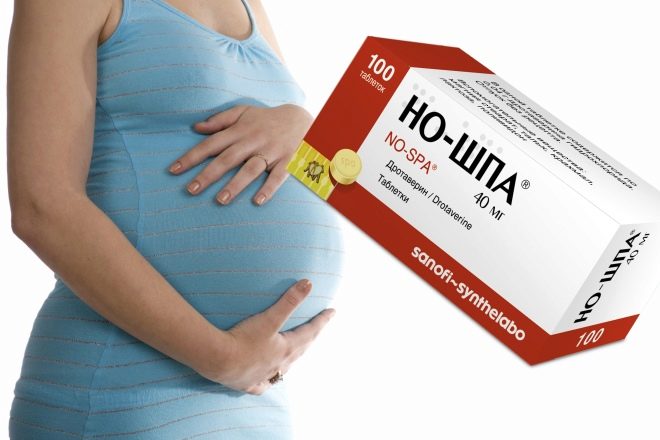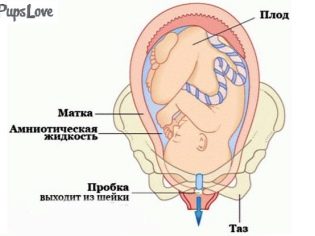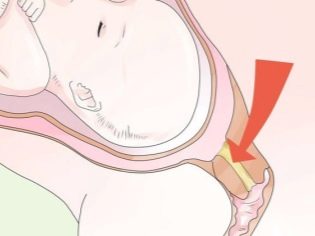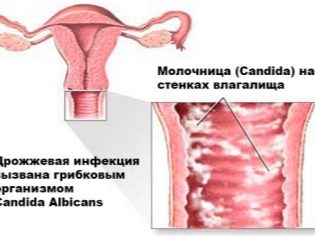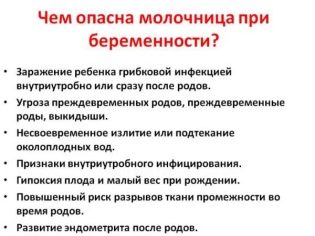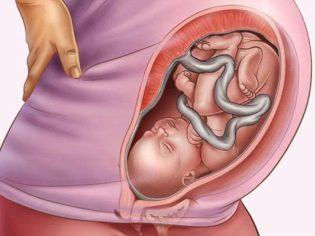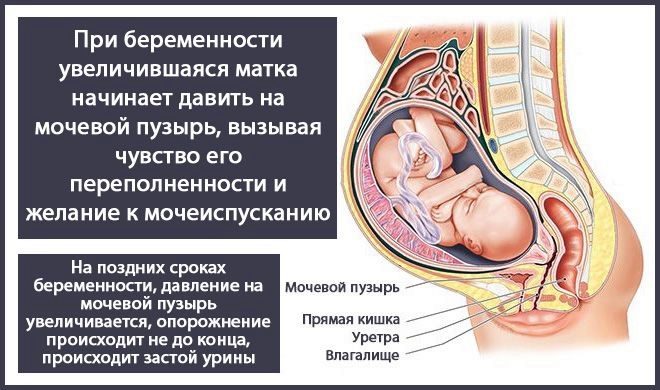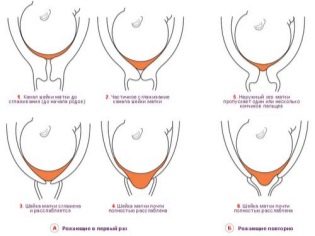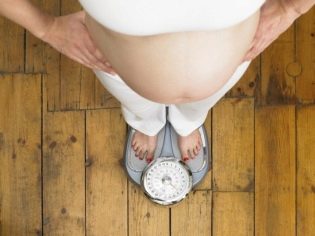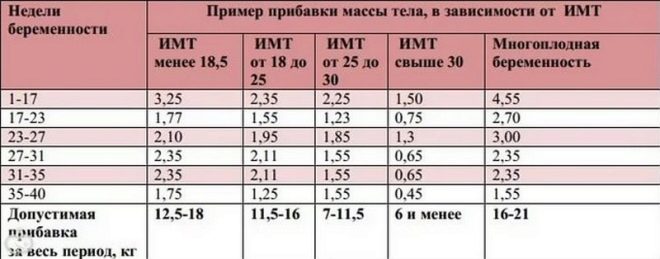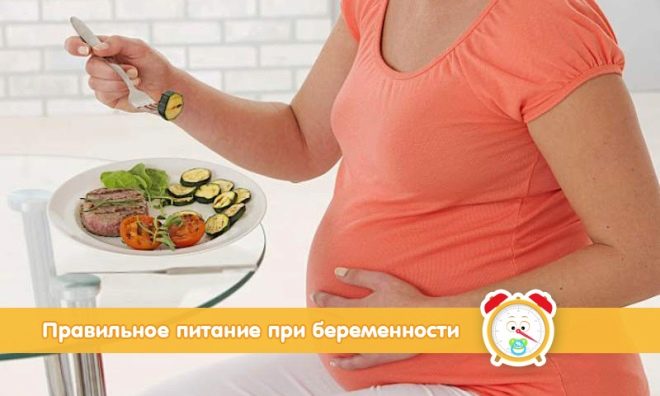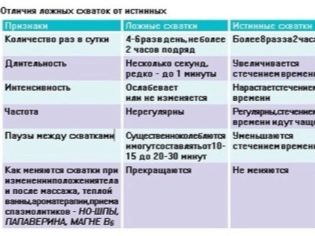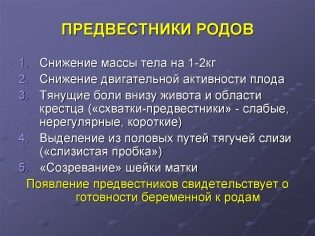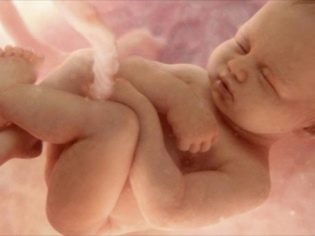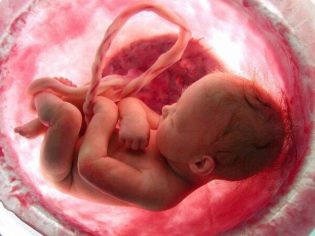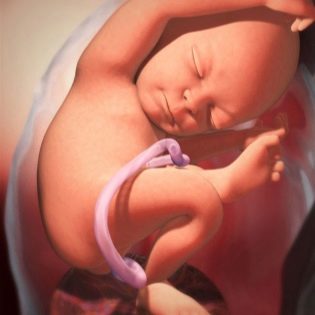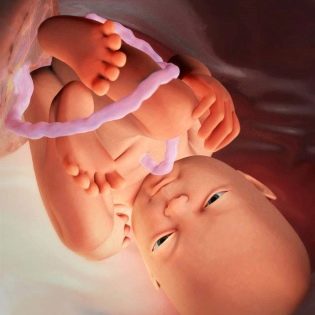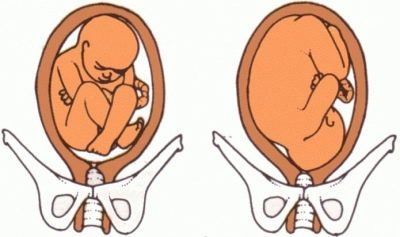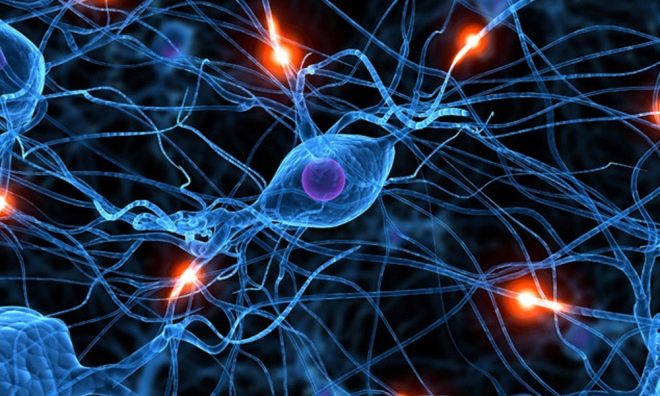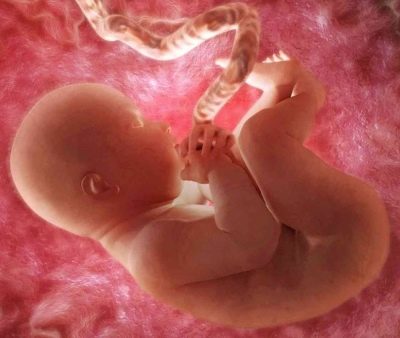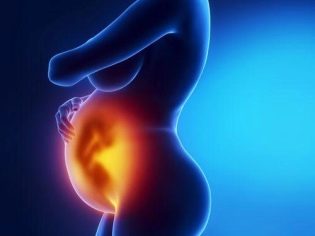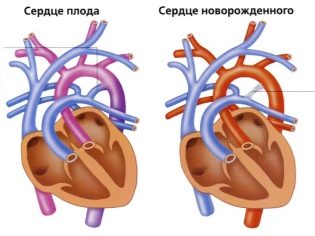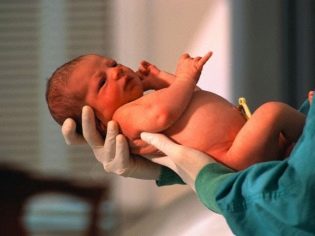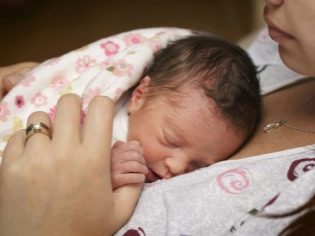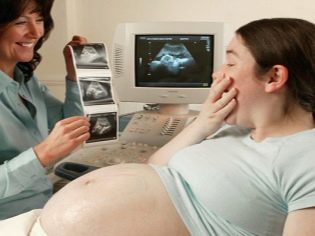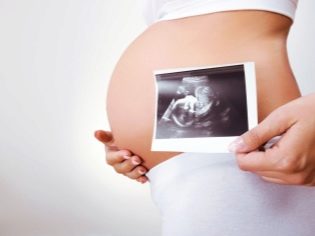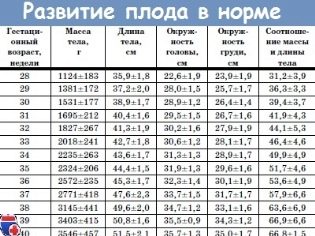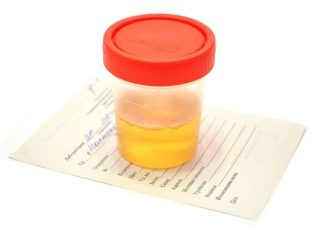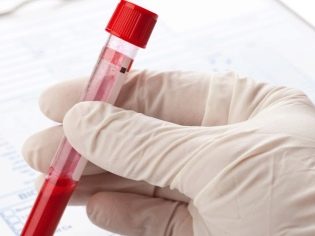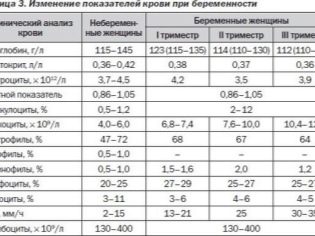37 week of pregnancy: what happens to the fetus and the expectant mother?
In the 37th week of pregnancy, a woman enters a completely new period - prenatal - now the baby is already considered fully mature, ready to be born. Some religions claim that right now the baby is finding its personal Guardian Angel. Until the meeting of the baby with her parents, there is very little left, and the woman now needs maximum patience and ability to concentrate on the main thing.
Childbirth can actually occur at any time, and therefore for this period it is better not to plan long journeys, long walks.
How many months is it
Week 37 opens the last month of pregnancy. The beginning of the 37th week is the beginning of the 10th obstetric month of pregnancy, the final stage of the third trimester. Behind nine obstetric months or 8 with a little months on the calculation of the usual, calendar. Almost 35 weeks passed from conception, and 33 weeks from delayed menstruation. An average of 4 obstetric weeks remains before delivery.
The estimated day of birth is a very arbitrary date, because it is on this day that only about 5% of babies are born. Most births occur earlier or later than the DA.
36-37 weeks of pregnancy is a very important and important time. A woman should know exactly what is happening during this period with a baby and a mother in order to be ready for different scenarios.
Feelings of the future mother
The most frequent question a woman hears at week 37 is when is the birth. This question is very annoying and makes the pregnant woman nervous, because she herself would like to know when they will come, because it becomes more difficult to wear the baby every day. Deep down, every expectant mother is well aware that the baby should be born on time to be fully ripe, but the desire to give birth quickly now prevails over common truths.
You can understand the future mom: the baby is already so big that carrying turns into a constant test of strength and endurance. The pains are aggravated, it is almost impossible to fully sleep, they suffer from insomnia, nausea, heartburn, diarrhea and constipation. Appetite that is, is missing. Awkwardness significantly limits the physical capabilities of the expectant mother, reduces her mobility.
For those who still have difficulty breathing due to the pressure of the uterus on the diaphragm, this week may become significantly easier. Most pregnant women have a belly down at 37 weeks. This means that the baby has gone down with its head; he has taken the position that is most correct and convenient for birth. His head tightly pressed to the exit of the small pelvis, the pressure on the diaphragm is reduced. A woman can breathe again with full breasts, but begins to constantly experience pressure in the lower abdomen, increased urge to urinate.
Many are interested in how long after the tummy is omitted, childbirth begins. There are no uniform standards in this - everything is individual. Usually, after omitting the crown head, it takes about 2-3 weeks before the start of the contractions.
Fetal movements
The movements of the baby are still a kind of "indicator" of his condition, but normally, at week 37, they become more rare. You should not be afraid of this, the reduction of perturbations is a physiological phenomenon. The baby has become big, now he does not have the physical ability to tumble and arrange "dances" as before, because the walls of the uterus already tightly cover his body, he occupies almost all free space in it.
The amount of amniotic fluid becomes smaller, the placenta begins to "lose weight" and thin out, its functions are almost fulfilled, it is aging.
At 37 weeks old, the child took the only position in which he could somehow fit in the uterus - flexion. In her baby's chin tightly pressed to the chest, arms and legs folded compactly, the baby itself is in a bent position. The movements in this position are very, very limited. The movements of the arms and legs now give the mother pain and discomfort.
Pregnant women are advised to continue to consider episodes of the motor activity of their son or daughter. Although they have become more rare, they, as before, should not be less than 10 in half a day. Start counting in the morning, counting on average lasts 12 hours. If the baby hiccups, this is not considered a stir. If he makes several consecutive movements in a short period of time, this is considered to be one movement. These are the general rules for counting.
The method that a woman will use when calculating can be anything. This is the popular Pearson method, Cardiff method, and other methods and methods among female clinics. The main thing is that the result was within the normal range.
If the movement is less than normal, this can be a sign of prolonged and prolonged hypoxia. The kid with a decrease in motor activity tries to save the oxygen that is so lacking for him.
Increased perturbations are usually characteristic of the initial stage of oxygen starvation. Anxiety crumbs, his sharp and short movements - is nothing but a way to get yourself more oxygen, so the baby massages the placenta, trying to pull the umbilical cord.
Hypoxia can be deadly for a baby. It often becomes the cause of prenatal death of a child at a late period, causes undesirable consequences for the health of the child, affects its nervous system, condition and performance of the brain.
The presence of hypoxia at week 37 is a reason for an urgent delivery, without waiting for the beginning of independent labor activity.
This information is provided for reference only, but not as a guide to action. This means that not every reduction of perturbations or their increase is necessarily associated with oxygen starvation. A woman should be more attentive to changing the behavior of her baby., but do not forget about its individual features, because at this time, the future mother already knows them.
There are more mobile and less mobile kids. In addition, a variety of external or internal factors, such as nutrition, weather, mood, and well-being of the expectant mother, affect the activity of the child in the womb.
Pains
A pregnant woman usually gets used to the pain. Various discomfort - now the constant "companions" of the woman, and the pain continues to intensify. In one woman they are more pronounced, in another - less, it all depends on the individual pain threshold. But everyone has pain at week 37, because the organism of the future mother is experiencing serious overload. Weight over the past months has increased markedly, because of this, there are periodic pains in the legs, knee joints, ankle. Often women on this period are concerned with cramps of the gastrocnemius muscles, they are associated with a lack of calcium in the body, because the child took it in large quantities.
The uterus continues to grow. This growth is now less intense than before, but the ligaments are stretched, overloaded, and this is what causes the woman to have sore back and back, there are nagging pains in the lower abdomen. Pulls the lower back, hurts in the right or left side is not constant, but mainly when you change the position of the body, with a long stay in an upright position.
Training bouts to 37 weeks of pregnancy are becoming more intense. They are happening more and more often, but this should not in any way bother the expectant mother. So her body is prepared for childbirth.
During this period, false or training contractions may occur in women who have already given birth earlier. In primiparas, they usually start long before delivery. The second or third pregnancy is characterized by the fact that Braxton-Hicks spasms appear shortly before the birth itself.
If there are no false contractions at week 37, this is also a variant of the norm. There are many women in the world who do not have such training cuts of the uterine muscles, and this does not prevent them from perfectly conveying and safely giving birth to their babies. Therefore, training battles do not belong to the category of precursors. They do not contribute to cervical dilatation.
It is very easy to recognize false contractions: the uterus briefly comes to a tone, and then relaxes. Repeated contractions may not be. And this is the main difference between false contractions and the real ones, which occur with a certain frequency and increase in pain.
The fact that childbirth began, can be judged by the frequency of contractions - they are repeated at specific intervals of time, amplified.
If the training bouts to the 37th week are greatly disturbed, the situation can be corrected by adopting the "No-silo", having rested in the prone position, having a warm shower. You should treat them calmly, without panic, as inevitable.
The crotch at week 37 hurts for two reasons: the head of the baby puts pressure on the pelvic structures, if the stomach is already lowered, and the pelvic bone apparatus is softening before the upcoming births.
The bones and ligaments become more mobile in order to skip the head of the child in the process of giving birth, to give him the opportunity to leave the uterus. A special hormone acts on the pelvic bones - relaxin, which is now being produced in the body of the expectant mother in large quantities.
Pain in the perineum is worse at night. The pubis may slightly restrict the movement of a woman in the morning after waking up. It will take some time for her to step back and let her sit, stand, rearrange her legs while walking.
If the pain is sharp, does not change and does not subside, then you should visit your doctor in order to prevent the development of symphysitis. This is an unpleasant complication of pregnancy. With him, with a high probability, the birth will be carried out by caesarean section.
37 obstetric week - the last opportunity to cure teeth. A visit to the dentist and any oral manipulations at a later date become undesirable. If a toothache hurts, do not postpone the visit to the doctor this week, especially since it is not necessary to endure the pain during dentistry. A woman at such a substantial time has already been allowed some anesthetic anesthetic drugs, so the doctor will do everything possible to ensure that the treatment is completed with minimal nerve costs for the woman in an “interesting position."
At 37 weeks of pregnancy, the cervix begins to actively prepare for childbirth. It is gradually shortened, smoothed out, it can cause minor nagging pains, as well as the feeling of short “piercing” lumboshes somewhere deep in the vagina. You should not be afraid - everything that happens is quite physiological and natural.
In the presence of pain of the following nature, an emergency room should be called at week 37: if they are sharp and strong, they are accompanied by bleeding or other unusual discharge, pouring out water, discharge of mucus plug. It is impossible to delay in this situation: the earlier a pregnant woman is in the hospital, the better for her and the unborn child.
Allotment
By changing the nature of vaginal discharge at week 37, a woman can guess the approach of labor or the onset of complications. In order not to miss the important, you should use thin daily sanitary pads.
Tampons for pregnant women can not be used because they cause accumulation of vaginal secretions, which in turn contributes to the multiplication of pathogenic bacteria.
Control of secretions - a prerequisite for their own hygiene during pregnancy in the later periods. Discharge at week 37 remains fairly abundant, just as a few weeks ago. However, this week a woman may notice that there are impurities of mucus in the vaginal secretions. This is the beginning of the discharge of the mucus plug, which for nine months securely closed the cervical canal from getting into it and from there into the uterine cavity of viruses and bacteria. Now the cervix begins to open slightly and the mucus plug can no longer be held in the expanding cervical canal.
Small impurities of mucus in the current term suggest that the cork moves away in parts, but if a large clot with blood streaks or without them is found on the gasket, the cork has come off entirely. From now on, a woman should not take a bath, should be limited to a shower, you should not have sex to prevent foreign microorganisms from entering the uterine cavity.
Cork does not always go off well in advance. Sometimes she leaves the cervical canal at the same time as the amniotic fluid is poured out, and then the cork can remain unnoticed by a woman. The waters themselves can also flow in parts. Watery discharges will indicate this to the woman.
Normally, the discharge at week 37 should remain white or slightly yellowish, have a smooth consistency, no clots, and no odor. If a woman appears any bleeding at this time, you should immediately call an ambulance.
Itching in the perineum may indicate the presence of thrush, especially if it is accompanied by thick white discharge resembling cottage cheese. Green, gray, brown discharge with an unpleasant smell this week is a sign of a genital infection.
It is necessary to get rid of thrush and infections before the onset of labor, therefore it is important to consult a doctor right now, because the treatment and rehabilitation of the genital tract will take some time.
Psychological state and mood of pregnant
Fear of the upcoming births still “reigns” in the minds of the expectant mother, but gradually he retreats and gives way to painful anticipation. Many women, tired of the heavy burden, want these “terrible” childbirths to start as soon as possible. Because of this, a woman may begin to experience a slight depression, become irritable and easily excitable.
Due to the fact that at night insomnia torments many people, they want to sleep all the time, but only during the day. Such a shift in the biological cycle causes a psychological imbalance, a woman may begin to feel that this period drags on very slowly and never ends.
It is in the last month of pregnancy that relations between spouses, a woman, and her parents often deteriorate. To help a woman at this stage, psychologists work in consultations. You should not be ashamed to seek psychological help, because this is completely normal, this practice is widespread throughout the civilized world.
The future mother now needs confidence in the future, in the fact that they will take care of her and her child, and also want to feel loved and needed.
Therefore, no matter how busy the future dad is at work, he should not forget that his second half is going through not the easiest times, she needs his support and participation.
Changes in the body
All systems and organs, each cell of the mother's body begin to prepare for the upcoming birth. This is a very complex from a biological point of view process, in which a variety of different mechanisms and substances are involved.
Uterus
The uterus occupies almost the entire space of the abdominal cavity. The height of its bottom - 32-37 centimeters. From the navel line, the uterus rises to 17-18 centimeters. If the baby has not dropped its head down, then it is difficult for the woman to breathe, because the bottom of the uterus props up the chest and diaphragm, squeezes the stomach. It is this fact that is the main cause of the very exhausting heartburn, which is familiar to almost all pregnant women, especially at the end of the third trimester.
The uterus, which presses on the diaphragm, creates the feeling that there is always not enough air. After abdominal prolapse, this disappears, but if omission did not occur at 37 weeks and it is still difficult to breathe, you should monitor your well-being and avoid the symptoms of lack of oxygen. To do this, a woman should occasionally take a knee-elbow position and take full breaths and exhalations in it. Such breathing exercises will help to cope with oxygen deficiency and help prepare for childbirth.
Because of the large uterus and its pressure on the bladder, a woman has frequent urge to urinate. To go to the toilet several times during the night, most pregnant women are getting used to this period, but troubles like urinary incontinence may surprise and perplex them. There is nothing terrible and strange about it. The pressure on the bladder increases the pressure on the sphincter, and now all you need to do is suddenly cough or laugh, so that the urine begins to leak.
The cervix begins to change rapidly. In the language of doctors - "ripen." The condition and length of the cervix are now making a conclusion about the probability of delivery in the near future. The neck becomes shorter - 24-26 mm, it may appear a little disclosure.
Normally, the first pharynx begins to unfold first and only then - the outer one. With obstetric pessary, which was established due to the weakness of the cervix in order to preserve the pregnancy earlier, it is usually hospitalized at week 37. After a general examination of the pregnant woman, the pessary is removed; after that, childbirth occurs within a few hours or days. If earlier surgical stitches were imposed on the cervix, it is now recommended to stay in the hospital.
The shorter the cervix at week 37, the more likely it is that delivery will occur very soon. Cervical ripening is an individual phenomenon, and if it has not yet begun, then there is a chance that the baby may last and the birth will happen after 40 weeks.
Weight gain
Weight gain at 37 weeks is already so great that a woman feels it literally with every part of her body. It became hard to walk, toss and turn from side to side. On average, by this time a woman adds up to 14 kilograms. And it is recommended to continue to be weighed not only on the days of the visit to the antenatal clinic, but also independently, at home, daily. Such control will help the pregnant woman to better understand the processes occurring in her body.
So, seemingly unreasonable jump of kilograms can speak about the development of preeclampsia. In this case, you should immediately consult a doctor to assess the degree and form of complications and decide on the further tactics of pregnancy.
Preeclampsia itself can be very dangerous for the mother and fetus, especially if weight gain is combined with the appearance of protein in the urine and an increase in blood pressure.
The components of the total weight gain for the entire period of pregnancy with normal indicators:
- About 30% - the weight of the baby.
- Just over 10% is allocated by weight of water and placenta.
- More than 12% is the weight of blood, the amount of which in the maternal organism has increased with the appearance of another circulation (uteroplacental).
- About 5% increase - the weight of the mammary glands.
- About 15% is diverted to the fluid that accumulates in the intercellular space of body tissues. If there is a lot of it, edema appears - internal and external.
What weight is considered normal at this time depends on the size of the woman.
- Fat women can add 8.3 kilograms to the 37th week of pregnancy, and this will fit into the standard values.
- Slender and subtle individuals normally can add about 14 kilograms.
- Women of average build - just over 12 kilograms.
Different doctors look at the rate of increase differently. This is due to the lack of uniform standardized requirements.
Within one week at this time you can add no more than 300 grams. A woman should remember that now her baby is very intensively gaining its own weight, and in order not to cause complaints from the obstetrician-gynecologist, it is important to eat small portions of food, whose caloric content is not high.
Many pregnant women say that weight loss began at week 37, and this is also quite normal. Water becomes less, the placenta decreases, besides, many say that appetite is almost gone.
Other changes
Complaints that the chest now hurts again, as at the very beginning of the gestational period, at week 37 are quite common. The mammary glands enter the final stage of preparation for lactation. The breasts become more sensitive, the nipples become coarse, they may begin to peel slightly. The excretion of colostrum is often enhanced. At 37 weeks, colostrum itself begins to become more fluid and whitish, whereas earlier it was thick and yellow.
By this time, colostrum is observed in the vast majority of pregnant women, but most often it accompanies a second or third pregnancy, provided that the woman had to breastfeed the baby earlier.
However, the absence of colostrum should not cause questions and concerns in a pregnant woman. The opinion that the absence of colostrum is a sign that there will be little or no breastmilk after delivery is wrong.
A large amount of circulating blood leads to instability in blood pressure levels. Therefore, there is nothing surprising in the fact that at week 37, it hurts or is dizzy, it throws into heat and cold, and the heart beats more often. A woman gets tired faster, she feels weaker than before. Headaches do not need medical treatment, doctors usually recommend a woman to sleep with an open window, and also to rest in a well-ventilated darkened room.
Anemia, if it was, begins to recede. At week 37, the level of hemoglobin in the blood of a pregnant woman increases. Estrogens, which are produced in considerable quantities, promote hair growth and not only in the head area. The sweat and sebaceous glands continue to work with increased activity, and therefore perspiration persists. But the nails due to lack of calcium become more fragile and fragile.
The skin of a woman is now more tender than ever. This is what causes the manifestations of allergies, increased pigmentation. At week 37, acne can manifest itself, about which a woman almost forgot when progesterone controlled everything in her body. Now hormones have changed, and this can manifest itself in the form of acne.
Harbingers of childbirth
What they, harbingers of childbirth, interests every pregnant woman. At 37 weeks, they may not be, and the first "swallows" may appear. Traditionally, the unconditional harbingers include:
- shortening of the cervix;
- lowering of the abdomen;
- leakage of amniotic fluid;
- gradual discharge of mucus plug.
There are also folk signs, on which our grandmothers and great-grandmother were guided, when no one measured the length of the cervix.The appearance of eating disorders, in particular, diarrhea, is usually attributed to precursors. It is believed that in this way the body of the future mother is trying to "cleanse" before the upcoming birth. However, do not confuse precursors and elemental food poisoning. In case of poisoning, the woman is accompanied by vomiting.
Strengthening training bouts - a rather dubious forerunner.
Often, popular rumor refers to the forerunners of the so-called nesting instinct, when a pregnant woman begins to actively develop their home, "build a nest." It is also considered a precursor to pulling pain between the legs, and insomnia. Many pregnant women claim that they almost stopped sleeping at night a week before giving birth.
Baby development
Your baby is busy with a very important business - it builds up fat and muscle mass. The average increase is 50 grams per day. The average weight of a fetus at 37 weeks gestation is 3100 grams. The estimated weight of the fetus can be determined by ultrasound, but the doctor will warn you that the concept is rather relative, and the errors can vary from 300-400 grams.
The growth of the baby reaches 47-49 centimeters. He is already quite large and it is very difficult for him to fit in the uterus. The baby looks just like a newborn, with one amendment - by weight. Otherwise, it is not much different from the newborn.
The whole small children's organism is now busy with the most important thing - preparing for their own birth, adaptive abilities are mobilized, the senses are “tuned”, the immunity is preparing to repel attacks of the aggressive world located outside the womb.
Appearance
In the form of a child there have been dramatic changes. Earlier, he looked thin and wrinkled, but now the baby has noticeably recovered, he already has plump cheeks, cute plump palms and heels. This is made possible by the process of accumulation of subcutaneous fat. Because of him, the skin has ceased to be red and wrinkled, and thanks to him, the baby can now keep warm, which is extremely important for his safe survival after birth.
From lanugo (thin blond hair), the skin of the baby is almost free. The original lubricant has been preserved only where it still has a protective need - in places of mechanical friction (under the arms, in the elbow and popliteal folds, in the groin). Only one out of two dozens of babies in week 37 has a portion of lanugo. But there is nothing pathological about this, the hairs will fall out in the first days after the birth of the child.
The length of the hair on the head of some babies already reaches impressive values - up to 5 centimeters, thanks to the coloring pigments, the baby may already be a brunette or brown-haired, red-haired or brown-haired. The cartilages of the nose and auricles have become more solid. Because of this, the ears stopped ridiculously hanging around in different directions and acquired a complete aesthetic appearance.
The child has his own individual eye color, structural features of the face, fingerprints, eyelashes and eyebrows are formed. Small nails have grown, and now the baby can scratch itself, because the nail plate confidently towers above the boundaries of the phalanxes. The proportions of the body have leveled off, become more balanced. The cranial bones remain mobile to facilitate the birth of the baby’s head.
Previa
Almost all the children at this time occupy a head position with respect to the exit from the small pelvis. That it is considered the most suitable and safe for the process of childbirth. If at 37 weeks the baby is in pelvic presentation, there is almost no chance that he will change his body position in the uterus. At this time, a decision is made to perform a cesarean section in order to minimize the likelihood of a child having severe disabling birth injuries.
Pelvic presentation, as well as the location across the uterine cavity - indications for cesarean section. It is usually carried out on a period of 38-39 or 39-40 weeks.
Before hospitalization, ultrasound is repeated, because there are cases in medicine where babies changed their position immediately before the onset of labor, although such stories are rare.
Nervous system
The baby's brain gained weight and significantly strengthened control over the activity of the entire child's body. The cerebral cortex has convolutions and grooves, the nerve endings myelinated. Young neurons continue to form at a very rapid pace, the nerve cells form the connections necessary for the child to develop further. This process will not end even after birth, the nervous system will continue its development in new conditions.
A few dozen formed reflexes will not let the baby disappear after he leaves the womb. All of them are now formed. These are sucking and swallowing reflexes, a grasping reflex, and a breathing reflex. In addition, there are several dozen tendon and tonic reflexes.
Nerve endings that permeate tender skin, are able to provide the brain with a full account of touching or changes in ambient temperature. Neural connections are formed between the "control center" (brain) and all the internal organs and systems of the child.
The sense organs are fully prepared for the baby’s independent life. He hears quite well how much the thickness of his mother’s abdominal wall allows, sees blurry color spots, visual acuity and focusing - the task of the near future after childbirth. He has a sense of smell and touch, the baby perfectly distinguishes tastes.
Internal organs
The internal organs of the baby are fully formed; now they only grow and grow in size and mass. The functions of each organ are perfected and streamlined, the child’s whole body works smoothly, like a clock. The boys' testicles have descended into the scrotum, but if the sex glands have lingered on the way from the abdominal cavity to the scrotum, then they will certainly fall in the coming days.
The lungs of the baby continue to accumulate a special substance necessary for survival and spontaneous breathing - surfactant. He is now in the alveoli is enough for the baby to breathe if the birth occurs this week. The surfactant does not allow the tiny bubbles, which are essentially the alveoli, to stick together while making the exit. These vesicles in the human body perform the functions of gas exchange - the release of carbon dioxide in exchange for oxygen.
In the baby’s liver, the formation of the lobules was completely completed, and the deep structures of the kidneys also acquired the final complete look. Now the kidneys produce up to 500 ml of urine per day, the baby drinks amniotic fluid and pees about once an hour. Urine enters the amniotic fluid, but the environment remains sterile due to the fact that the composition of the water is updated every three hours.
In the intestines by the 37th week a large amount of original cala - meconium had accumulated. It consists of bile and lanugo particles that are undigested by the baby’s stomach and flaky epithelium. As the kid starts already after his birth, in the first day or two he will bring out exactly this first feces, meconium of dark green color.
If a bowel movement now occurs in utero, the doctors will try to speed up the birth of the baby, because meconium makes the water unsuitable for ingestion, moreover, the fact of intrauterine defecation is very alarming because it often indicates a clear fetus trouble - hypoxia or Rh conflict.
The heart of the baby works smoothly, pumping up to two dozen liters of blood per day. It knocks rhythmically, clearly and loudly. If you wish, you can hear it by placing an ear on your pregnant belly.
Viability
Premature birth at 37 weeks are called only conditionally. Pregnancy is considered full-term, and children born this week are certainly viable. But a lot depends on the individual development of the baby.Sometimes it happens that the amount of accumulated surfactant in the lungs is not enough, sometimes babies born at week 37 do not have enough subcutaneous fat to effectively retain their own heat.
Therefore, children who are born on this period are under the closest control of neonatologists for several days, some babies need resuscitation measures and special conditions of stay for several days after birth. However, often babies born at 37 weeks, in the absence of complications, are immediately applied to the chest and after a day are transferred to the same ward as their mother.
Even if the baby is not brought and kept in intensive care, you should not worry. He spent in the mother's womb enough time to successfully adapt to the external environment. Health effects should not be.
Your baby on ultrasound
Ultrasound in the 37th week of pregnancy is carried out mainly for medical reasons. Such indications are in cases where the doctor needs to know exactly the length of the cervix, the size of the fetal head, its intended weight, if a large or giant fetus is suspected. These data are needed in order to choose the tactics of delivery. Ultrasound helps to determine the degree of readiness of the baby for birth, the readiness of his lungs, presentation.
Ultrasound on week 37 can be the final, the last for the entire period of carrying the baby. To do it yourself only radio in order to admire the crumbs or find out his sex, in fact there is no point.
The child’s posture in the mother’s womb does not allow the doctor to carefully examine the genitalia of the baby, so the diagnosis of sex is now very difficult, and the probability of error is high.
Indicator of the development of the baby is fetometriya. The main dimensions of the head and paired bones allow the doctor to present the proportions of the body of the baby, to calculate the expected weight. Internal organs are assessed, as well as motor activity and the heartbeat of a small heart. Close attention to this period is paid to the placenta.
The rates for fetometry for 37 weeks are as follows.
BPR, mm | LZR, mm | Thigh length, mm | The length of the bones of the tibia, mm | The length of the humerus, mm | The length of the bones of the forearm, mm | Head circumference, mm | Abdominal circumference, mm |
85-99 | 106-126 | 66-76 | 59-68 | 59-69 | 51-60 | 307-353 | 299-361 |
A deviation from the specified values is acceptable, but not more than two weeks. If the baby lags behind the norm by 2 weeks or more, doctors may suspect him of intrauterine growth retardation. Children with advanced values are more likely to be born large.
At week 37, it is recommended not to perform an ordinary ultrasound scan, but an ultrasound scan with a Doppler, so that it is possible to evaluate the work of the placenta, the blood flow velocity in the uteroplacental vessels. This information is needed in order to understand how comfortable a baby feels in her mother's womb.
Hazards and Risks
The main danger at week 37 is falling and injury. The stomach has become so big that a woman, when walking, does not see her own legs, does not see where she is going. This is especially dangerous in the winter, if a woman makes independent walks alone. But at home you should walk as carefully as possible, because the gait of a pregnant woman is now unstable, you can literally stumble and fall on level ground.
The woman’s immunity continues to be weak, the natural protection has been suppressed for too long by progesterone to recover quickly, so there is a high risk of contracting influenza or ARVI. And even the common cold can trap at any time. Therefore, it is now important to refrain from visiting crowded places, busy and crowded shopping centers, to avoid traveling in public transport, especially if there is an epidemic season outside.
The very common cold or a viral infection for the child no longer poses any danger, but it can greatly complicate the life of the expectant mother.With a runny nose and cough, if childbirth begins, a woman is hospitalized exclusively in the observational (infectious) department of the maternity hospital.
Treat colds or SARS in the 37th week of pregnancy, if a woman is still sick, you need only under the supervision of a doctor, because inept self-treatment can do much more harm than the disease itself. The doctor will help you choose a drug that is safe for the child’s health, and will tell you which of the traditional remedies are permissible. The disease can be overcome without serious complications.
A woman should not lift weights, be very nervous, because all this can lead to childbirth ahead of time. Even the fact that the baby is considered viable does not negate the need for the last weeks of gestation and cannot be underestimated. Violent emotions, bad habits can also accelerate the course of events, and if nature intends to carry a baby for 40 weeks, then it is dangerous to go against it. Do not rush to the hospital.
Quite often at week 37, a woman is haunted by a delicate and painful problem - hemorrhoids. No need to believe that everything will pass by itself: childbirth, as practice shows, only reinforces the manifestations of hemorrhoids. Therefore, right now, you need to consult with your doctor and begin treatment, adjust nutrition, avoid constipation. Loose stools, too, can not be ignored. Diarrhea can lead to dehydration.
Analyzes and surveys
At the 37th week of pregnancy, a woman will receive an impressive list of directions for tests that need to be carried out before delivery: such a comprehensive check on the health status of the future mother will help doctors to better navigate in the last weeks of pregnancy and during birth.
Before the planned reception in the antenatal clinic still complete urinalysis. It is needed in order to know how the kidneys cope with the load, whether the woman has signs of gestosis or gestational diabetes.
This week, a woman is recommended to take a general and detailed biochemical blood tests, make a blood test for antibody titers if the woman has a negative Rh factor, and also make a coagulogram — an analysis showing hemostasis. This is important to determine if the future mother has any blood clotting disorders, as the clan process, whatever the technique and methods, is always associated with a lot of blood loss.
A blood test for HIV, syphilis, hepatitis B and C is given once more. If, according to ultrasound data, the placenta is recognized as aging too quickly, the woman will be recommended a blood test for concentration and balance of various hormones. All pregnant women, regardless of the history, at 37 obstetric weeks, CTG is performed to make sure that the baby is all right.
Recommendations to the future mother
The main tips in the 37th week of pregnancy are swaying proper nutrition, adherence to a rest regimen, attentive attitude to changes in one's own body. Besides:
If severe itching of the skin in the chest, abdomen, and thigh areas, the woman should definitely use special anti-stretch cosmetics. You can get by with a more economical option - after a shower, rub heated almond, linseed or sunflower oil into the skin;
sex is not contraindicated and even useful, because the orgasm helps the uterine muscles to prepare for childbirth, and the semen contains prostaglandins, which contribute to the preparation of the cervix for disclosure. However, sex must be very careful.
If there is a threat of premature birth, if the cork has come off, water is leaking, sex is contraindicated.
Pregnant Reviews
Future moms at this time share the secrets of recognizing harbingers of childbirth, and also compare what helps better from frequent training fights - “Papaverine" or "No-shpa". Most pregnant women claim that their state of health has become somewhat worse than the week before.
About what happens to the fetus and the future mother at 37 weeks of pregnancy, see below.
